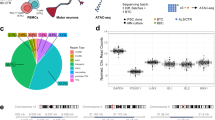Abstract
A quantitative, cytochemical assay for measuring lysosomal enzymes in the peripheral nerves of mice has been developed. That the time course of lysosomal enzyme changes after misonidazole (MISO) treatment reflects the degree of neurotoxicity of this agent in the mouse, has been confirmed by the use of two known neurotoxic compounds: methyl mercury and acrylamide. This effect is specific to the peripheral nerves and was not found in liver, kidney, heart or cerebral cortex. Enzyme activities varied with mouse strain and sex, as did the response to MISO treatment. Of the mice studied, female C57 gave the greatest increase in beta-glucuronidase activity. With the MISO dose of 0.6 mg/g/dose the increased enzyme activity was independent of the route of administration and appeared to approach a plateau after 5 daily doses.
This is a preview of subscription content, access via your institution
Access options
Subscribe to this journal
Receive 24 print issues and online access
$259.00 per year
only $10.79 per issue
Buy this article
- Purchase on Springer Link
- Instant access to full article PDF
Prices may be subject to local taxes which are calculated during checkout
Similar content being viewed by others
Rights and permissions
About this article
Cite this article
Clarke, C., Dawson, K. & Sheldon, P. Quantitative cytochemical assessment of the neurotoxicity of misonidazole in the mouse. Br J Cancer 45, 582–587 (1982). https://doi.org/10.1038/bjc.1982.95
Issue Date:
DOI: https://doi.org/10.1038/bjc.1982.95



